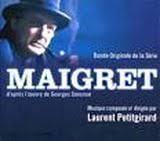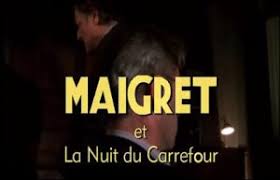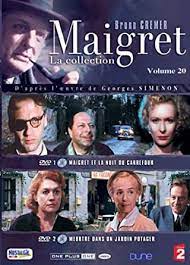IMDb meta-data is runtime of 1 hour and 28 minutes, rated 7.6 by 95 cinematizens.
Genre: Krimi.
Verdict: Shrouded.

A one-man flying squad of Maigret arrives at the crossroads where he spends a long night, well, several of them. The film is atmospheric, much of it at night on a flat plain where there are three dwellings around the intersection, each about on a hundred metres apart in a triangle: the garage/petrol station with house, the salesman’s new and modern – circa 1947 – villa, and the weathered, brooding gothic mansion. At the petrol station is the garrulous proprietor and his taciturn wife along with a spiv and a pensioner to do the work. The salesman lives with his scowling wife in that villa. At the mansion is the sou-less Baron and his sister. These latter two are German, and the baron was disfigured in the war on the Russian Front.
The only interaction among the three is at the petrol pump. The salesman uses a lot of fuel on his calls, while the Baron drives to Paris once a month in a rattletrap to deliver his latest designs and get paid. The sister is seldom seen at all. The wife watches the crossroads from her perch in the kitchen window. The garage proprietor is the only one out and about, here and there at all hours. Trucks taking produce to Les Halles pass at all hours of the day and night, many stopping for petrol and a few words.
The Carrefour des Trois Veuves is so named for the three widows who once lived in the mansion and who, according to local legend, murdered each other (no doubt in a quarrel over the TV remoter having no man to hog it). It is late autumn with leafless trees, damp and dank air, and waterlogged fields, stretching away. The soggy, foggy atmosphere is well-rendered. (It was filmed in Luxembourg.)

Maigret has arrived because a Belgian diamond merchant has been found shot to death at the crossroads. Later when she arrives his widowed wife, too, is shot dead. The NRA hunting season is in full swing, targeting Belgians rather school children this time. Per his normal modus operandi Maigret moves into a nearby auberge and walks about absorbing the ambience, meeting the people of the crossroads who number no more than eight. Both the wives bear husband-inflicted bruises about which he asks, only to be fobbed off by the women.
It is a different set up from the book. The biggest difference in all of three films I have seen so far is the removal of Maigret from Paris and the second most significant is the absence of his team: Lucas, Janvier, LaPointe, and Torrence. Lucas is the dogged 2iC with an encyclopaedic memory for files; Janvier supplies the muscle assisted by Torrence, and young LaPointe is the fresh face who is good at getting people to talk to him. None have surfaced in these episodes to date. Tant pris.

In the book the foreigner is Danish and no baron, but remains a struggling artist with his sister. The sister is played by an actor who married a baron and perhaps that generated the idea of titling the brother. Though why he is made a German is anyone’s guess, and it jars since the Maigret books seldom (never?) refer to the wider context. Bruno Cremer once again brings Maigret to life. Slow, uncertain but persistent, surprised but steadfast he ploughs on.
In the film there much more gunfire than one expects from a Maigret title, and I read the novel to see if it is there, too. Yep Maigret in a very un-Maigret gesture does shoot a hole in an inner tube in the garage to see what is inside it. Yes, there is shoot ‘em up in the book as in the film. By the way, he carries the gun in his coat pocket! Not NRA recommended.
The Baron is so obsessed by his sister/wife that he tries to protect her, even knowing she conspired in his attempted murder by gunshot and later herself tried to smother him with a pillow. A moth to the flame is he. Will she be lucky the third time?

